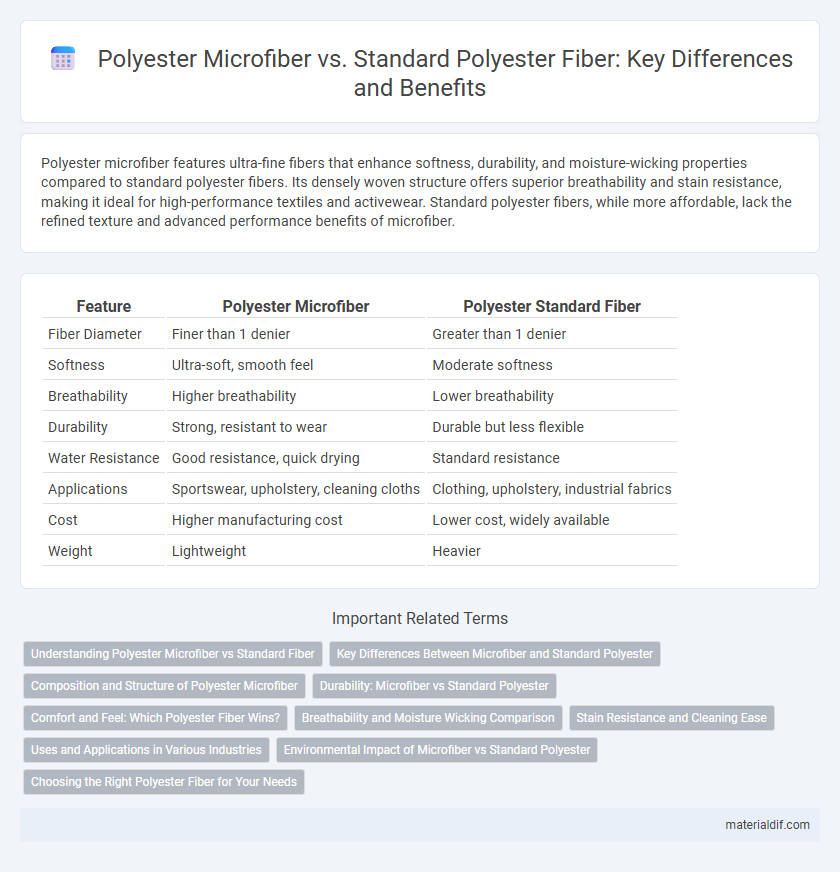Polyester microfiber features ultra-fine fibers that enhance softness, durability, and moisture-wicking properties compared to standard polyester fibers. Its densely woven structure offers superior breathability and stain resistance, making it ideal for high-performance textiles and activewear. Standard polyester fibers, while more affordable, lack the refined texture and advanced performance benefits of microfiber.
Table of Comparison
| Feature | Polyester Microfiber | Polyester Standard Fiber |
|---|---|---|
| Fiber Diameter | Finer than 1 denier | Greater than 1 denier |
| Softness | Ultra-soft, smooth feel | Moderate softness |
| Breathability | Higher breathability | Lower breathability |
| Durability | Strong, resistant to wear | Durable but less flexible |
| Water Resistance | Good resistance, quick drying | Standard resistance |
| Applications | Sportswear, upholstery, cleaning cloths | Clothing, upholstery, industrial fabrics |
| Cost | Higher manufacturing cost | Lower cost, widely available |
| Weight | Lightweight | Heavier |
Understanding Polyester Microfiber vs Standard Fiber
Polyester microfiber fibers measure less than one denier, offering finer, softer, and more breathable fabric compared to standard polyester fibers which typically range from 1.5 to 3 deniers. Microfiber polyester provides enhanced moisture-wicking and superior durability, making it ideal for high-performance textiles and activewear. Standard polyester fibers, while more affordable and sturdy, lack the smooth feel and advanced moisture management properties found in microfiber variants.
Key Differences Between Microfiber and Standard Polyester
Polyester microfiber consists of ultra-fine fibers typically less than one denier in diameter, offering a softer texture, higher breathability, and enhanced moisture-wicking compared to standard polyester fibers. Standard polyester fibers are thicker, usually around 1.5 to 5 denier, resulting in increased durability and less water absorption but a coarser feel. The finer weave of microfiber also improves stain resistance and flexibility, making it preferable for high-performance textiles and apparel.
Composition and Structure of Polyester Microfiber
Polyester microfiber consists of ultrafine fibers with diameters less than one denier, significantly finer than standard polyester fibers, resulting in a higher surface area and enhanced softness. Its composition remains primarily polyethylene terephthalate (PET) but is engineered through advanced spinning techniques to create split fibers, increasing porosity and breathability. This structural modification improves moisture-wicking properties and durability compared to traditional polyester standard fibers.
Durability: Microfiber vs Standard Polyester
Polyester microfiber exhibits superior durability compared to standard polyester fibers due to its finer denier, which enhances tensile strength and resistance to abrasion. The high density of microfiber yarns provides greater resilience against wear and tear, making it ideal for applications requiring long-lasting fabric performance. Standard polyester fibers, while durable, tend to be less resistant to pilling and surface damage under heavy use.
Comfort and Feel: Which Polyester Fiber Wins?
Polyester microfiber offers superior softness and a smoother texture compared to standard polyester fiber, enhancing overall comfort in clothing and upholstery applications. The finer fibers of microfiber create a lightweight, breathable fabric that feels more like natural fibers, reducing skin irritation and increasing wearability. Standard polyester fiber, while durable and wrinkle-resistant, tends to be coarser and less breathable, making microfiber the preferred choice for comfort-focused products.
Breathability and Moisture Wicking Comparison
Polyester microfiber offers superior breathability compared to standard polyester fiber due to its finer threads that allow better air circulation and ventilation. The enhanced surface area of microfiber significantly improves moisture-wicking capabilities, quickly drawing sweat away from the skin to keep the wearer dry and comfortable. Standard polyester fibers, while durable and quick-drying, generally trap more heat and moisture, making microfiber the preferred choice for activewear and performance fabrics focused on breathability and moisture management.
Stain Resistance and Cleaning Ease
Polyester microfiber offers superior stain resistance compared to standard polyester fiber due to its densely woven structure, which minimizes liquid absorption and prevents deep-set stains. The finer fibers in polyester microfiber enable easier cleaning and quicker drying, reducing the effort required to maintain fabric appearance. Standard polyester fibers, while durable, tend to absorb more liquids and retain stains longer, making them less efficient for stain management and cleaning.
Uses and Applications in Various Industries
Polyester microfiber offers superior softness and flexibility, making it ideal for high-performance athletic wear, upholstery, and delicate apparel, whereas standard polyester fiber is commonly used in durable items like industrial fabrics, tarps, and home textiles. The finer denier and enhanced moisture-wicking properties of microfiber drive its application in medical textiles and filtration systems. Standard polyester fiber, valued for its strength and cost-effectiveness, dominates in packaging, automotive interiors, and geotextiles.
Environmental Impact of Microfiber vs Standard Polyester
Polyester microfiber, due to its finer structure, sheds more microplastics during washing compared to standard polyester fibers, intensifying aquatic pollution and posing a greater environmental risk. Standard polyester, while still synthetic and reliant on petrochemical resources, tends to release fewer microfibers yet persists in the environment due to its non-biodegradable nature. Evaluating environmental impact requires balancing microfiber pollution with overall fiber durability and resource use to guide sustainable textile choices.
Choosing the Right Polyester Fiber for Your Needs
Polyester microfiber offers superior softness, breathability, and moisture-wicking properties compared to standard polyester fiber, making it ideal for activewear and high-performance textiles. Standard polyester fiber is more durable and cost-effective, suitable for upholstery, home decor, and general-purpose fabrics. Selecting the right polyester fiber depends on whether comfort, functionality, or budget is the main priority for your specific application.
Polyester Microfiber vs Polyester Standard Fiber Infographic

 materialdif.com
materialdif.com